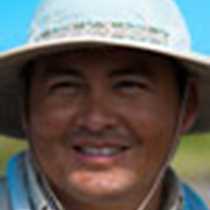After two days on the western side of the archipelago, today the National Geographic Endeavour was anchored in Santiago Island. The central islands in the Galapagos show different ecosystem and our guests enjoyed different activities. The day started with an early outing on Espumilla Beach. Guests were eager to explore the island where the most famous naturalist in the world – Charles Darwin – spent nine days collecting specimens that led him to the development of the theory of evolution through natural selection. Our explorers were fascinated by the fearlessness of the top predator of the Galapagos Islands, the Galapagos hawk. A dozen hawks were gliding in the area while we were disembarking on an inorganic sandy beach that is often used by the green sea turtle to nest. As soon as we were on land the fearless hawks begin landing and perching on the dry branches of the bottom mangroves. In addition, blue-footed boobies were plunging, diving in the shallow areas of the beach, and a great blue heron looking for baby turtles into the mangroves was also sighted. Our early exploration on the island paid off.
After breakfast we explored the island with other alternatives offered by our expedition leader. Kayaking was a great alternative to approach close to the huge cliff of Buccaneer Cove. Kayakers spotted swallow tailed gulls, brown pelicans, and noddies among other migratory birds. Snorkeling was also significant activity today. The visibility was fantastic; stingrays, white-tipped sharks, galapagos fur seals, sea lions and a great variety of colorful fish delighted our guests in the water and also those that opted to be dry and cozy enjoying the glass bottom boat.
Late in the morning an unexpected visitor surprised us; a short ear owl flew from the island of Santiago to the deck of the National Geographic Endeavour. This close encounter with one of the main predators in the Galapagos gave us another perspective of what is to be in a natural, fragile ecosystem and why is important to keep it natural.
In the afternoon young explorers went to the beach to relax and practice more snorkeling. The black sand beach with sea lions and marine iguanas offers a nice, comfy environment. Later, other guests joined us to explore the island in more detail. A long walk along the coastline with sally light foot crabs, birds, iguanas and sea lions ended in a place where the old lava flow formed huge gas bubbles that collapsed and today are filled with ocean water. This quiet place is safe for Galapagos fur seals to congregate. On our way back we were inspired by what Mother Nature had prepared, the sun setting behind the shield volcanoes of Isabela. We sat and devoted a minute of silence to those species that are no longer are present in the Galapagos Islands due to invasive species that were brought by humans in the 18th century.








